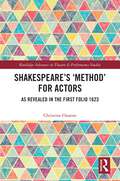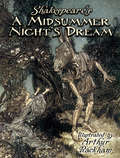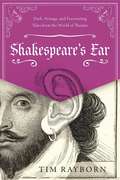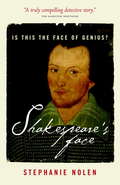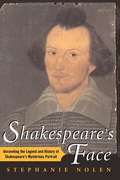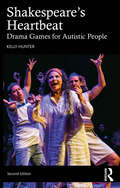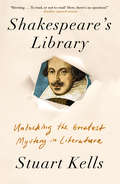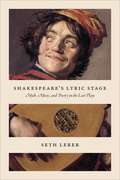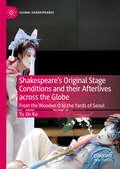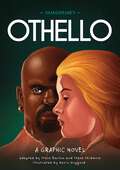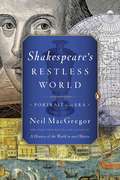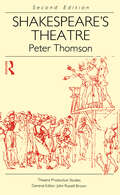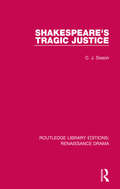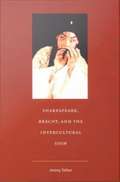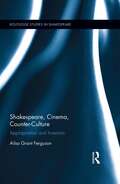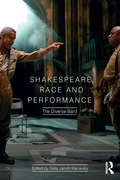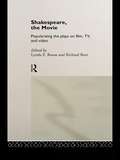- Table View
- List View
Shakespeare's 'Method' for Actors: As Revealed in The First Folio 1623 (Routledge Advances in Theatre & Performance Studies)
by Christine OzanneBy using only the First Folio text, this book acts as an original guide to performing Shakespeare’s plays.This book is the accumulation of the many Clues from the First Folio of Shakespeare’s plays (as opposed to any edited version) that help to inform contemporary performances and offers a complete understanding of the text. This study compares the original acting of Shakespeare's plays with the modern method of rehearsing and performing theatre and film productions. It likens today’s screen actors’ limited preparation time for their performances, with the Elizabethan acting company’s restricted conditions for theirs. This book covers in-depth analysis of thirty Clues, some of which have been edited out in modern versions, thereby losing the effect of the useful Clue. Here is a clear and intelligent view of the riches to be mined in the text contained in the 1623 First Folio.New insights into all the plays are given to actors, directors, teachers and people who care about the works of William Shakespeare and it is a companion volume to Patrick Tucker’s Shakespeare’s First Folio Cue Scripts (Routledge 2024).
Shakespeare's A Midsummer Night's Dream
by William Shakespeare Arthur RackhamShakespeare's incomparable romantic comedy takes on a new and vivid life in these brilliant images by one of the 20th century's leading illustrators. The fairy world of A Midsummer Night's Dream is the perfect milieu for the artistry of Arthur Rackham, a popular illustrator of fairy tales who possessed a striking gift for depicting fanciful creatures. His dreamlike visions provide a series of unique portraits from the enchanted wood outside ancient Athena, where Oberon and Titania rule a kingdom of diminutive sprites. <p><p> Rackham's career coincided with the era known as the Golden Age of Illustration, an age that witnessed the rise of increasingly sophisticated color printing techniques. His interpretation of A Midsummer Night's Dream, which first appeared in 1908, received the full benefit of the improved technology, and this faithful reprint offers a quality of printing and sharpness of reproduction that rivals the limited and first editions. The complete text of the play appears here, along with 40 full-color and numerous black-and-white illustrations — a splendid tribute by a master of fantasy art to an immortal play.
Shakespeare's Botanical Imagination (Environmental Humanities in Pre-modern Cultures)
by Susan C. StaubWriting on the cusp of modern botany and during the heyday of English herbals and garden manuals, Shakespeare references at least 180 plants in his works and makes countless allusions to horticultural and botanical practices. Shakespeare’s Botanical Imagination moves plants to the foreground of analysis and brings together some of the rich and innovative ways that scholars are expanding the discussion of plants and botany in Shakespeare’s writings. The essays gathered here all emphasize the interdependence and entanglement of plants with humans and human life, whether culturally, socially, or materially, and vividly illustrate the fundamental role plants play in human identity. As they attend to the affinities and shared materiality between plants and humans in Shakespeare’s works, these essays complicate the comfortable Aristotelian hierarchy of human-animal-plant. And as they do, they often challenge the privileged position of humans in relation to non-human life..
Shakespeare's Ear: Dark, Strange, and Fascinating Tales from the World of Theater
by Tim RaybornShakespeare’s Ear presents dark and sometimes funny pieces of fact and folklore that bedevil the mostly unknown history of theater. All manner of skullduggery, from revenge to murder, from affairs to persecution, proves that the drama off-stage was just as intense as any portrayed on it. The stories include those of: An ancient Greek writer of tragedies who dies when an eagle drops a tortoise on his head. A sixteenth-century English playwright who lives a double life as a spy and perishes horribly, stabbed above the eye. A small Parisian theater where grisly horrors unfold on stage. The gold earring that Shakespeare wears in the Chandos portrait, and its connections to bohemians and pirates of the time. Journey back to see theatrical shenanigans from the ancient Near East, explore the violent plays of ancient Greece and Rome, revel in the Elizabethan and Jacobean golden age of blood-thirsty drama, delight in the zany and subversive antics of the Commedia dell’arte, and tremble at ghostly incursions into playhouses. Here you will find many fine examples of playwrights, actors, and audiences alike being horrible to each other over the centuries.
Shakespeare's Face
by Stephanie NolenOn May 11, 2001, Globe and Mail reporter Stephanie Nolen announced a stunning discovery to the world: an attractive portrait held by an Ontario family for twelve generations, which may well be the only known portrait of Shakespeare painted during his lifetime. Shakespeare's Face is the biography of a portrait -- a literary mystery story -- and the furious debate that has ensued since its discovery.A slip of paper affixed to the back proclaims "Shakespere. This likeness taken 1603, Age at that time 39 ys." But is it really Shakespeare who peers at us from the small oil on wood painting? The twinkling eyes, reddish hair, and green jacket are not in keeping with the duller, traditional images of the bard. But they are more suggestive of the humorous and humane man who wrote the greatest plays in the English language.Shakespeare's Face tells the riveting story of how the painting came to reside in the home of a retired engineer in a mid-sized Ontario town. The painting is reputed to be by John Sanders of Worcester, England. As a retirement project, the engineer, whose grandmother kept the family treasure under her bed, embarked on authenticating the portrait: the forensic analyses that followed have proven it without doubt to the period.In a remarkable publishing coup, Knopf Canada has gathered around Stephanie Nolen's story a group of the world's leading Shakespeare scholars and art and cultural historians to delve into one of the most fascinating literary mysteries of our times: "Is this the face of genius?"Excerpt from Chapter 1 of Shakespeare's Face by Stephanie NolenBy the late afternoon I was beginning to go a little cross-eyed. I had examined countless documents and read the test results from the painting's painstaking forensic analysis. I now had everything I needed to write my story -- except for one crucial item. "Is he here?" I asked, almost in a whisper....The owner laid the package carefully on the cluttered table. He gently pulled back the kraft paper wrapping, underneath which was a layer of bubble wrap. Then he peeled back this second layer to reveal his treasure.I was caught off-guard by how small the portrait was -- and how vivid. The colours in the paint seemed too rich to be 400 years old. Except for the hairline cracks in the varnish, the face could have been painted yesterday. And there was nothing austere or haughty about it, nothing of the great man being painted for posterity. It was a rogue's face, a charmer's face that looked back at me with a tolerant, mischievous slightly world-weary air....It was painted on two pieces of solid board so expertly joined that the seam was barely visible. A date, "Ano 1603", was painted in small red letters in the top right hand corner. The right side had been nibbled by woodworms.... I stood and gazed, quelling an instinctive urge to pick the portrait up and hold it in my hands. And as my professional skepticism crumpled for a moment, I found myself wanting desperately to believe that this was indeed Shakespeare's face.
Shakespeare's Face: Unraveling the Legend and History of Shakespeare's Mysterious Portrait
by Stephanie NolenA fascinating literary detective story charting the surprising, true history of a recently discovered painting of Shakespeare held by the same family for 400 years -- adding new drama to the Bard's life.When author Stephanie Nolen reported the discovery of the only portrait of William Shakespeare painted while he was alive, the announcement ignited furious controversy around the world.Now, in this provocative biography of the portrait, she tells the riveting story of how a rare image of the young Bard at thirty-nine came to reside in the suburban home of a retired engineer, whose grandmother kept the family treasure under her bed, and how he embarked on authenticating it. The ultimate Antiques Roadshow dream, the portrait has been confirmed by six years of painstaking forensic studies to date from around 1600, and it has not been altered since.
Shakespeare's Heartbeat: Drama Games for Autistic People
by Kelly HunterThis updated and revised edition of Shakespeare’s Heartbeat offers a step-by-step guide detailing how to demonstrate, play and perform sensory games based on two of Shakespeare’s most popular plays designed for autistic people of all ages. The original games of heartbeats, eye contact and spatial awareness were created at the Glebe School, Beckenham, with a group of twelve autistic teenagers who met and played with Kelly Hunter once a week over three years, 2002-2005. This second edition brings the book up to date with the additional knowledge Kelly Hunter has gained since then as the founding artistic director of Flute Theatre, the world’s only Shakespearean troupe to focus on the needs of autistic audiences. The book includes the following: A new chapter dedicated to performing A Midsummer Night’s Dream and The Tempest with autistic audiences, including Hunter’s adapted, interactive performance texts of both plays. A new resource for playing with younger autistic children and their families. A new resource for playing with those who require a lower demand approach. A new chapter with targets and techniques to understand the autism puzzle more clearly. New games based on A Midsummer Night’s Dream and The Tempest which have been created over the last ten years, in addition to the original games detailed in the first edition. This book provides an indispensable learning tool for theatre practitioners, drama students, applied theatre students, teachers, autistic people and their families.
Shakespeare's Heartbeat: Drama games for children with autism
by Kelly HunterChildren on the autistic spectrum experience varying degrees of difficulties; all of which can be understood as a disassociation of mind and body. Expressing feelings, making eye contact, keeping a steady heartbeat and recognizing faces are all part of the autism dilemma which can be poetically explored by Shakespeare. Over ten years, Hunter worked with children on all points of the spectrum, developing drama games for the specific purpose of combatting autism. These unique games, derived from specific moments in the plays, shed new light on how to teach Shakespeare to children, using the drama as an exploration of how it feels to be alive. Shakespeare’s Heartbeat is a step-by-step guide, detailing how to demonstrate, play and share these sensory games. The book includes: Games based on A Midsummer Night’s Dream Games based on The Tempest Tips and advice for playing one-on-one with the children An afterword describing Hunter’s journey from performer and practitioner to creator of this work. Shakespeare’s poetic definitions of seeing, thinking and loving reveal the very processes that children with autism find so difficult to achieve. This book provides an indispensable learning tool for those wishing to encourage children’s eye contact and facial expression, improve their spatial awareness and language skills and introduce them to imaginative play.
Shakespeare's Library: Unlocking the Greatest Mystery in Literature
by Stuart KellsA tantalizing true story of one of literature’s most enduring enigmas is at the heart of this “lively, even sprightly book” (Michael Dirda, The Washington Post)—the quest to find the personal library of the world’s greatest writer.Millions of words of scholarship have been expended on the world’s most famous author and his work. And yet a critical part of the puzzle, Shakespeare’s library, is a mystery. For four centuries people have searched for it: in mansions, palaces and libraries; in riverbeds, sheep pens and partridge coops; and in the corridors of the mind. Yet no trace of the bard’s manuscripts, books or letters has ever been found.The search for Shakespeare’s library is much more than a treasure hunt. Knowing what the Bard read informs our reading of his work, and it offers insight into the mythos of Shakespeare and the debate around authorship. The library’s fate has profound implications for literature, for national and cultural identity, and for the global Shakespeare industry. It bears on fundamental principles of art, identity, history, meaning and truth.Unfolding the search like the mystery story that it is, acclaimed author Stuart Kells follows the trail of the hunters, taking us through different conceptions of the library and of the man himself. Entertaining and enlightening, Shakespeare’s Library is a captivating exploration of one of literature’s most enduring enigmas."An engaging and provocative contribution to the unending world of Shakespeariana . . . An enchanting work that bibliophiles will savor and Shakespeare fans adore." ―Kirkus Reviews
Shakespeare's Lyric Stage: Myth, Music, and Poetry in the Last Plays
by Seth LererWhat does it mean to have an emotional response to poetry and music? And, just as important but considered less often, what does it mean not to have such a response? What happens when lyric utterances—which should invite consolation, revelation, and connection—somehow fall short of the listener’s expectations? As Seth Lerer shows in this pioneering book, Shakespeare’s late plays invite us to contemplate that very question, offering up lyric as a displaced and sometimes desperate antidote to situations of duress or powerlessness. Lerer argues that the theme of lyric misalignment running throughout The Tempest, The Winter’s Tale, Henry VIII, and Cymbeline serves a political purpose, a last-ditch effort at transformation for characters and audiences who had lived through witch-hunting, plague, regime change, political conspiracies, and public executions. A deep dive into the relationship between aesthetics and politics, this book also explores what Shakespearean lyric is able to recuperate for these “victims of history” by virtue of its disjointed utterances. To this end, Lerer establishes the concept of mythic lyricism: an estranging use of songs and poetry that functions to recreate the past as present, to empower the mythic dead, and to restore a bit of magic to the commonplaces and commodities of Jacobean England. Reading against the devotion to form and prosody common in Shakespeare scholarship, Lerer’s account of lyric utterance’s vexed role in his late works offers new ways to understand generational distance and cultural change throughout the playwright’s oeuvre.
Shakespeare's Original Stage Conditions and their Afterlives across the Globe: From the Wooden O to the Yards of Seoul (Global Shakespeares)
by Yu Jin KoThis book brings together two separate fields by combining a study of Shakespeare's original stage conditions with an exploration of his plays in performance across the globe. The book contributes new insights into how early-modern stage conditions shaped the writing, production, and reception of Shakespeare's plays, but takes the further step of examining how original stage conditions re-emerge, not only in Globe replicas like the London Globe, but in unexpected and sometimes unconscious reconfigurations in adaptations and productions from around the world: film versions of Othello from Mexico to India that take dancing cues and anxieties about dance from the play and centralize dance; Korean adaptations for the madang (or yard) that reimagine Shakespeare's theatrical spaces and their relationships to audiences; Noh re-imaginings on film and onstage that foreground the theatrical; a teen film remake of Othello that raises questions about how blackness is figured today and on Shakespeare's stage, among others. By studying original stage conditions and their global afterlives, the book illuminates how global productions negotiate historical and cultural differences and thereby, paradoxically, engage with the cultural specificities of the present.
Shakespeare's Othello: A Graphic Novel (Classics in Graphics #8)
by Steve Skidmore Steve BarlowShakespeare's Othello like you've never seen it - or read it - before! Classics in Graphics: Othello has been adapted into a graphic novel by expert authors, Steve Skidmore and Steve Barlow, with illustrations by Kevin Hopgood and Martyn Cain. Watch Iago's slimy plan play out like an irresistible thriller - as Othello's self-doubt turns to fury and becomes more and more consuming.Classics in Graphics is a series of graphic novels for readers aged 10 plus that has inclusion at its heart, flinging wide the doors of literature for all to enter and understand. Including dyslexia-friendly design and encouraging readers to relate to iconic roles - casting spells, falling in love and winning duels. Each graphic novel includes pitch-perfect illustrations for depicting tragedy, romance, comedy or magic PLUS: - snappy simplified text presenting Shakespeare's themes clearly - introductory materials to help set the scene and context of each story - heaps of extra material at the back to keep the learning and fun going, including an exploration of themes in the play, the language, Shakespeare's inspirations, the publication and performance of the play in history, a timeline of Shakespeare's life and works, and much more! Plays available in the series include: Macbeth, The Tempest, Hamlet, Romeo and Juliet, A Midsummer Night's Dream, Much Ado About Nothing, Othello, Twelfth NightPraise for Classics in Graphics: "[...] an encouraging entry point to Shakespeare for my kids, and [...] an excellent job converting challenging language and literary themes to make it very inclusive, smoothing ease of understanding dialogue, plot, and narration without dumbing it down." - EricWilliamson, leagueofcomicgeeks.com
Shakespeare's Possible Worlds
by Simon PalfreyNew methods are needed to do justice to Shakespeare. His work exceeds conventional models, past and present, for understanding playworlds. In this book, Simon Palfrey goes right to the heart of early modern popular drama, revealing both how it works and why it matters. Unlike his contemporaries, Shakespeare gives independent life to all his instruments, and to every fraction and fragment of the plays. Palfrey terms these particles 'formactions' - theatre-specific forms that move with their own action and passion. Palfrey's book is critically daring in both substance and format. Its unique mix of imaginative gusto, thought experiments, and virtuosic technique generates piercing close readings of the plays. There is far more to playlife than meets the eye. Influenced by Leibniz's visionary original model of possible worlds, Palfrey opens up the multiple worlds of Shakespeare's language, scenes, and characters as never before.
Shakespeare's Restless World
by Neil MacgregorWilliam Shakespeare lived through a pivotal period in human history. With the discovery of the New World, the horizons of Old Europe were expanding dramatically, long-cherished certainties were crumbling and life was exhilaratingly uncertain. What ideas and assumptions did Londoners bring with them when they went to see Shakespeare's plays in the 1590s and 1600s - what were they thinking? What was it like living in a world so radically different from anything their parents had experienced?Shakespeare's Restless World uncovers the fascinating stories behind 20 objects from Shakespeare's life and times to recreate his world and the minds of his audiences. The objects range from the rich (such as the hoard of gold coins that make up the Salcombe treasure) to the very humble, like the battered trunk and worn garments of an unknown pedlar. Each of them allows MacGregor to explore one of the defining themes of the Shakespearean age - globalisation, reformation, piracy, Islam, magic and many others. MacGregor weaves Shakespeare's words themselves into the histories of his objects to suggest where his ideas about religion, national identity, the history of England and the world, human nature itself, may have come from. The result is an excitingly fresh and unexpected portrait of Shakespeare's dangerous and dynamic world.
Shakespeare's Storytelling: An Introduction to Genre, Character, and Technique
by Nate EastmanShakespeare’s Storytelling: An Introduction to Genre, Character, and Technique is a textbook focused on specific storytelling techniques and genres that Shakespeare invented or refined. Drawing on examples from popular novels, plays, and films (such as IT, Beloved, Sex and the City, The Godfather, and Fences) the book provides an overview of how Shakespearean storytelling techniques including character flaws, conflicts, symbols, and more have been adapted by later writers and used in the modern canon. Rather than taking a historicist or theoretical approach, Nate Eastman uses recognizable references and engaging language to teach the concepts and techniques most applicable to the future study of Creative Writing, English, Theater, and Film and Media. Students will be prepared to interpret Shakespeare’s plays and understand Shakespeare as the beginning of a literary tradition. A readable introduction to Shakespeare and his significance, this book is suitable for undergraduates.
Shakespeare's Theatre (Theatre Production Studies)
by Peter ThomsonReviews of the First Edition `...valuable and enjoyable reading for all studying Shakespeare's plays.' Following in the patternestablished by John Russell Brown for the excellent series (Theatre and Production Studies), he provides first an account of Shakespeare's company, then a study of three individual plays Twelfth Night, Hamlet and Macbeth as performed by the company. Peter Thomson writes in a crisp, sharp, enlivening style.' TLS '`...the best analysis yet of Elizabethan acting practices, excavated form the texts themselves rather than reconstructed on basis of one monolithic theory, and an essay on Hamlet that is a model of Critical intelligence and theatrical invention.' Yearbook of English Studies `Synthesizes the important facts and summarizes projects with a vigorous prose style, and expertly applies his experience in both practical drama and academic teaching to his discussion.' Review of English Studies
Shakespeare's Tragic Justice (Routledge Library Editions: Renaissance Drama)
by C. J. SissonThe problem of justice seems to have haunted Shakespeare as it haunted Renaissance Christendom. In this book, first published in 1963, four aspects of the problems of justice in action in Shakespeare’s great tragedies are explored. This study is based on the lifetime’s research of Elizabethan habits of mind by one of the most distinguished Shakespearean scholars, and will be of interest to students of English Literature, Drama and Performance.
Shakespeare's Twelfth Night: A Graphic Novel (Classics in Graphics #7)
by Steve Skidmore Steve BarlowShakespeare's Twelfth Night like you've never seen it - or read it - before! Classics in Graphics: Twelfth Night has been adapted into a graphic novel by expert authors, Steve Skidmore and Steve Barlow, with illustrations by Wendy Tan Shiau Wei. Experience the famous (and famously confusing) love triangle, presented with all the flair of your favourite rom-com.Classics in Graphics is a series of graphic novels for readers aged 10 plus that has inclusion at its heart, flinging wide the doors of literature for all to enter and understand. Including dyslexia-friendly design and encouraging readers to relate to iconic roles - casting spells, falling in love and winning duels. Each graphic novel includes pitch-perfect illustrations for depicting tragedy, romance, comedy or magic PLUS: - snappy simplified text presenting Shakespeare's themes clearly - introductory materials to help set the scene and context of each story - heaps of extra material at the back to keep the learning and fun going, including an exploration of themes in the play, the language, Shakespeare's inspirations, the publication and performance of the play in history, a timeline of Shakespeare's life and works, and much more! Plays available in the series include: Macbeth, The Tempest, Hamlet, Romeo and Juliet, A Midsummer Night's Dream, Much Ado About Nothing, Othello, Twelfth NightPraise for Classics in Graphics: "[...] an encouraging entry point to Shakespeare for my kids, and [...] an excellent job converting challenging language and literary themes to make it very inclusive, smoothing ease of understanding dialogue, plot, and narration without dumbing it down." - EricWilliamson, leagueofcomicgeeks.com
Shakespeare, Brecht, and the Intercultural Sign
by Antony TatlowIn Shakespeare, Brecht, and the Intercultural Sign renowned Brecht scholar Antony Tatlow uses drama to investigate cultural crossings and to show how intercultural readings or performances question the settled assumptions we bring to interpretations of familiar texts. Through a "textual anthropology" Tatlow examines the interplay between interpretations of Shakespeare and readings of Brecht, whose work he rereads in the light of theories of the social subject from Nietzsche to Derrida and in relation to East Asian culture, as well as practices within Chinese and Japanese theater that shape their versions of Shakespearean drama. Reflecting on how, why, and to what effect knowledges and styles of performance pollinate across cultures, Tatlow demonstrates that the employment of one culture's material in the context of another defamiliarizes the conventions of representation in an act that facilitates access to what previously had been culturally repressed. By reading the intercultural, Tatlow shows, we are able not only to historicize the effects of those repressions that create a social unconscious but also gain access to what might otherwise have remained invisible. This remarkable study will interest students of cultural interaction and aesthetics, as well as readers interested in theater, Shakespeare, Brecht, China, and Japan.
Shakespeare, Cinema, Counter-Culture: Appropriation and Inversion (Routledge Studies in Shakespeare #17)
by Ailsa Grant FergusonAddressing for the first time Shakespeare’s place in counter-cultural cinema, this book examines and theorizes counter-hegemonic, postmodern, and post-punk Shakespeare in late 20th and early 21st century film. Drawing on a diverse range of case studies, Grant Ferguson presents an interdisciplinary approach that offers new theories on the nature and application of Shakespearean appropriations in the light of postmodern modes of representation. The book considers the nature of the Shakespearean inter-text in subcultural political contexts concerning the politicized aesthetics of a Shakespearean ‘body in pieces,’ the carnivalesque, and notions of Shakespeare as counter-hegemonic weapon or source of empowerment. Representative films use Shakespeare (and his accompanying cultural capital) to challenge notions of capitalist globalization, dominant socio-cultural ideologies, and hegemonic modes of expression. In response to a post-modern culture saturated with logos and semiotic abbreviations, many such films play with the emblematic imagery and references of Shakespeare’s texts. These curious appropriations have much to reveal about the elusive nature of intertextuality in late postmodern culture and the battle for cultural ownership of Shakespeare. As there has yet to be a study that isolates and theorizes modes of Shakespearean production that specifically demonstrate resistance to the social, political, ideological, aesthetic, and cinematic norms of the Western world, this book expands the dialogue around such texts and interprets their patterns of appropriation, adaptation, and representation of Shakespeare.
Shakespeare, Performance and the Archive
by Barbara HodgdonShakespeare, Performance and the Archive is a ground-breaking and movingly written exploration of what remains when actors evacuate the space and time of performance. An analysis of ‘leftovers’, it moves between tracking the politics of what is consciously archived and the politics of visible and invisible theatrical labour to trace the persistence of performance. In this fascinating volume, Hodgdon considers how documents, material objects, sketches, drawings and photographs explore scenarios of action and behaviour – and embodied practices. Rather than viewing these leftovers as indexical signs of a theatrical past, Hodgdon argues that the work they do is neither strictly archival nor documentary but performative – that is, they serve as sites of re-performance. Shakespeare, Performance and the Archive creates a deeply materialized historiography of performance and attempts to make that history do something entirely new. Barbara Hodgdon is Professor of English at the University of Michigan, now retired. Her major interest is in theatrical performances, especially performed Shakespeare. She is the author of: The End Crowns All, The Shakespeare Trade, and most recently the Arden edition of The Taming of the Shrew.
Shakespeare, Race and Performance: The Diverse Bard
by Delia Jarrett-MacauleyWhat does it mean to study Shakespeare within a multicultural society? And who has the power to transform Shakespeare? The Diverse Bard explores how Shakespeare has been adapted by artists born on the margins of the Empire, and how actors of Asian and African-Caribbean origin are being cast by white mainstream directors. It examines how notions of 'race' define the contemporary British experience, including the demands of traditional theatre, and it looks at both the playtexts themselves and contemporary productions. Editor Delia Jarrett-Macauley assembles a stunning collection of classic texts and new scholarship by leading critics and practitioners, to provide the first comprehensive critical and practical analysis of this field.
Shakespeare, Revenge Tragedy and Early Modern Law: Vindictive Justice (Early Modern Literature in History)
by Derek DunneThis book, the first to trace revenge tragedy's evolving dialogue with early modern law, draws on changing laws of evidence, food riots, piracy, and debates over royal prerogative. By taking the genre's legal potential seriously, it opens up the radical critique embedded in the revenge tragedies of Kyd, Shakespeare, Marston, Chettle and Middleton.
Shakespeare, The Movie II: Popularizing the Plays on Film, TV, Video and DVD
by Richard Burt Lynda E. BooseFollowing on from the phenomenally successful Shakespeare, The Movie, this volume brings together an invaluable new collection of essays on cinematic Shakespeares in the 1990s and beyond. Shakespeare, The Movie II:*focuses for the first time on the impact of postcolonialism, globalization and digital film on recent adaptations of Shakespeare;*takes in not only American and British films but also adaptations of Shakespeare in Europe and in the Asian diapora;*explores a wide range of film, television, video and DVD adaptations from Almereyda's Hamlet to animated tales, via Baz Luhrmann, Kenneth Branagh, and 1990s' Macbeths, to name but a few;*offers fresh insight into the issues surrounding Shakespeare on film, such as the interplay between originals and adaptations, the appropriations of popular culture, the question of spectatorship, and the impact of popularization on the canonical status of "the Bard."Combining three key essays from the earlier collection with exciting new work from leading contributors, Shakespeare, The Movie II offers sixteen fascinating essays. It is quite simply a must-read for any student of Shakespeare, film, media or cultural studies.
Shakespeare, The Movie: Popularizing the Plays on Film, TV and Video
by Richard Burt Lynda E. BooseShakespeare, The Movie brings together an impressive line-up of contributors to consider how Shakespeare has been adapted on film, TV, and video, and explores the impact of this popularization on the canonical status of Shakespeare.Taking a fresh look at the Bard an his place in the movies, Shakespeare, The Movie includes a selection of what is presently available in filmic format to the Shakespeare student or scholar, ranging across BBC television productions, filmed theatre productions, and full screen adaptations by Kenneth Branagh and Franco Zeffirelli. Films discussed include:* Amy Heckerling's Clueless* Gus van Sant's My Own Private Idaho* Branagh's Henry V* Baz Luhrman's William Shakespeare's Romeo and Juliet* John McTiernan's Last Action Hero* Peter Greenaway's Prospero's Books* Zeffirelli's Hamlet.
